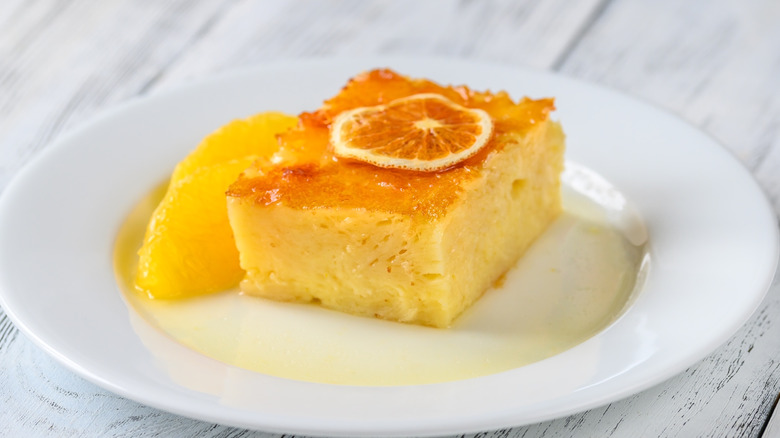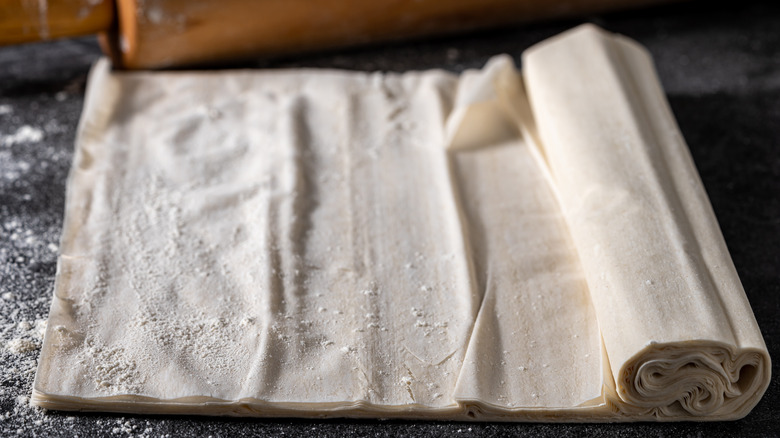Portokalopita: The Greek Orange Cake Packed With Shredded Phyllo
Raise your hand if phyllo dough freaks you out. Yes, the struggle with this pesky pastry is real. While it makes some of the most delicious foods in the world (hello, spanakopita), the fickle nature of the tissue-thin dough can be off-putting. In order to work with it, it can't dry out (which it tends to do very quickly) and it can't tear (yeah, right). It's likely that someone, somewhere along the way — probably in a little Greek house — had enough one day, threw these rules out the window, and created portokalopita, a dessert that means orange pie in Greek.
In terms of American tastes and expectations, portokalopita is nothing like a traditional pie, but more like a cake with the texture of bread pudding. No stranger to citrus fruits in its long history as a country, Greece produces vast amounts of oranges under its sunny skies. According to Greek mythology, the goddess Hera grew numerous orange trees in the Garden of Hesperides. Those who ate them received immortality, thus beginning their popularity in Greek cuisine. If this tale were true, eating one slice of portokalopita would, no doubt, guarantee an endless life due to the wonderful amount of sweet orange in this unique dessert.
Portokalopita's Greek origins
On the island of Crete sits Lefkon Oreon, a mountain range whose snowmelt trickles down into the valleys where vast orchards of orange trees grow. This is where portokalopita originated, in a place where oranges are plentiful and used in many dishes, especially in the winter when they are at peak ripeness. It's not entirely clear who first made the cake, but a popular theory credits Greek household cooks (typically the women of the house) as the creators. Portokalopita uses dry strips and bits of phyllo dough, and it is believed that the women (never ones to waste anything) took leftover pieces of the dry dough and turned them into cakes, flavoring them with oranges.
Portokalopita is in a class of Greek desserts called siropiasta which denotes sweets that are soaked in syrup after they are baked while they're still hot, like baklava. The syrup is left to fully absorb, giving the desserts a signature, almost juicy texture. One of the most surprising elements of portokalopita is that there is no flour in it. Remember that dried phyllo? It's this that acts as the binding agent.
No flour? No problem
The first step to making portokalopita might be the best part because you get to release all of your phyllo-related frustrations. Separate individual sheets of the dough and let them either air-dry or dry in a low-heat oven. Don't worry about keeping the sheets straight, as you will eventually crumble them up. The soaking syrup is made by combining sugar, water, fresh orange juice and zest, and a cinnamon stick. This is heated until the sugar dissolves, and you end up with a syrup, which should cool completely. For the cake, the list of ingredients usually includes eggs, sugar, Greek yogurt, oil, baking powder, orange zest and juice, and vanilla. Once this is combined, you stir in the dried shreds of phyllo dough until everything is well combined. The mixture is poured into a greased baking dish and baked until the top is browned.
After removing the pan from the oven, slowly pour the cooled orange syrup all over the top and let it absorb into the cake. Let the pan sit in the refrigerator until it is completely cooled. The resulting sweet should be intensely orange-scented and flavored, with a custardy texture. Some say portokalopita is best a couple of days after it is baked so that all of the flavors get concentrated, but it can certainly be eaten the day you make it once it's cooled. Top slices with creamy Greek yogurt or vanilla ice cream.
Simple to make in your own home
You will, of course, find portokalopita all over Greece and the island of Crete, not to mention in Greek homes around the world. To this day, it's still made in especially large amounts in the winter to celebrate orange season. You certainly don't need to book a ticket to Athens to give it a try; the ingredient list and method of baking is pretty simple and most well-stocked kitchens already have most of the ingredients in their refrigerators and pantries.
Many people put their own spins on the dessert, including incorporating chocolate chips or chocolate sauce in or on the cake (a classic pairing) or adding toasted nuts inside the cake. The fact that it is traditionally served cold makes it wonderfully refreshing to enjoy in the summer, but if you prefer, you can also warm up individual slices for a toasty treat. You can store leftovers in the refrigerator, but avoid freezing the cake altogether. Once it's thawed, the phyllo will turn soggy, and there is already enough delicious moisture in the cake anyway.



